|
--- What should they do? --- Design of loudspeakers --- Loudspeaker evaluation --- Accurate
stereo --- Whatever happened? ---
--- Room acoustics --- Sound field control --- Other designs --- System
design ---
Whatever happened to the quality
of
reproduced sound in the home?
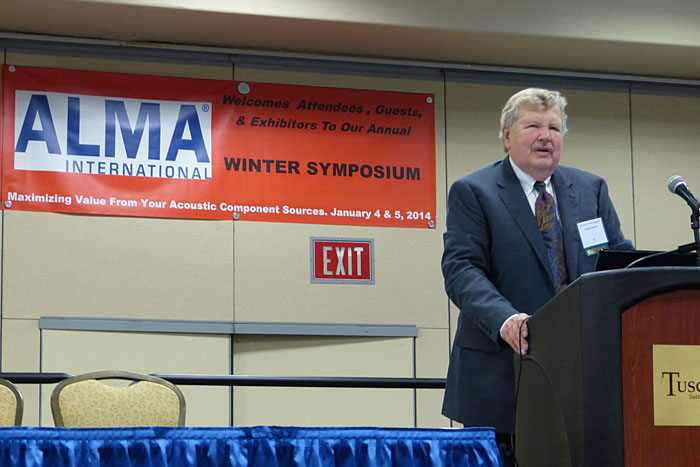
Keynote Address by Siegfried Linkwitz at ALMA International Winter
Symposium, 2014
Abstract:
Sound quality is judged by the realism of the auditory
illusion, which is created in the listener’s mind, created from the sounds
coming directly from the loudspeakers and by reflections and reverberations from
the room, arriving from various directions and with different timings. The
original sound streams from the musicians - performing in their acoustical
environment - to the listener in his home have undergone significant changes in
processing over the last 50 years, leading to dramatic improvements in dynamic range
and bandwidth due to digital technology, but also to new forms of distortion.
Electro-acoustic transducers have kept up with the developments. But
loudspeakers built with those transducers have only marginally improved,
especially when tasked to create a convincing aural scene, which takes the
listener to the recording venue space in a typical size living room. The
interactions between loudspeaker, room and hearing processes have
not been sufficiently studied and premature conclusions have been drawn about
loudspeaker design parameters. The typical loudspeaker comes with fundamental flaws, which
critical listeners try to correct by room treatment. The solution would be a
loudspeaker with spectrally neutral radiation in all directions. Such
loudspeakers are extremely rare. In general, the quality of reproduced sound in
the home has reached a plateau that is uninspiring to the Apple and Google
generation.
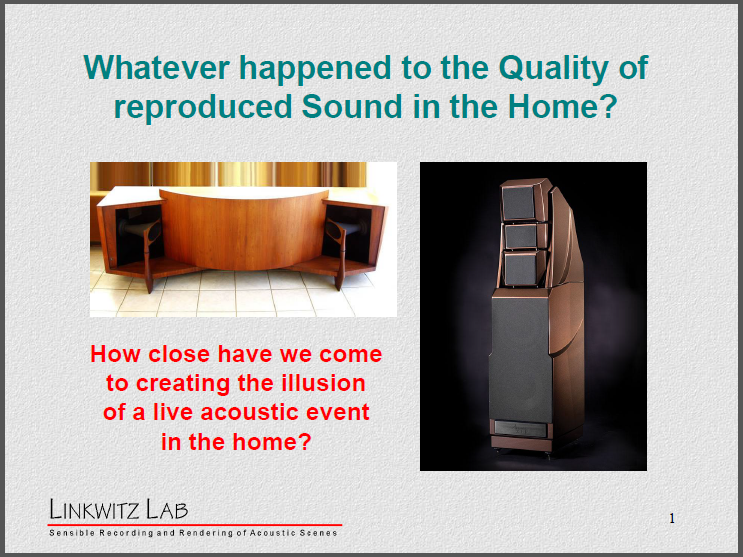
1) Whatever happened to the quality of reproduced sound in
the home?
By quality I mean:
How close have we come to creating the illusion of a live acoustic event in the
home?
And in particular if we try to create this illusion from two loudspeakers in
a living room?
Stereo is an auditory illusion created in the mind
by the sound streams coming from left and right loudspeakers and by reflections
of those sounds in the listening room, and by the room reverberated
sounds. Stereo is like a magic trick, an auditory trick that is experienced with
closed eyes. If it is well done, then the listener is not aware of the
speakers or his room and he has the illusion of a phantom stage in front of
him, hearing into a concert hall or having the musicians right there.
Whatever happened to the quality of the auditory magic
trick over the last 50 years?
I picked a 50 year time frame because that is how long I have been involved with
loudspeakers as a hobby, to satisfy my personal needs and expectations.
My professional career has been with Hewlett-Packard Company, with 37 years in
Research and Development of electronic test equipment. Audio was an interest
amongst many engineers and we designed and built our own Hi-Fi systems.
Here we see a high-end loudspeaker console from the late
fifties and a contemporary high-end loudspeaker. Did sound quality, the
believability of the auditory illusion improve over the years?
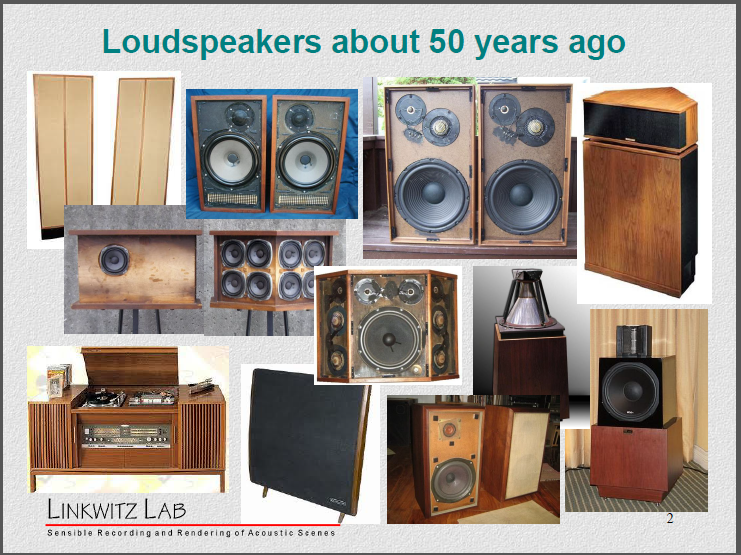
2) Loudspeakers about 50 years ago
At the time high-end audio had moved away from the
integrated Stereo console (Musiktruhe in German) to a component stereo system.
The console was a piece of living room furniture that had combined the stereo
speakers with an AM/FM radio, a record player and a tape recorder.
The loudspeakers of the component system carried names
like:
KLH9 electrostatics, Dynaco A25, AR3, Klipsch horn,
Bose 901, AR LST, Ohm/Walsh,
Quad ESL, Advent and ESS with Heil air motion transformer
Note the variety in types of transducers, of cabinet
shapes and how transducers are placed on the baffle. Why these differences?
Being an engineer I had a strong desire to understand the technical reasoning.
We were somewhat familiar with electromagnetic antenna design in the 20 MHz to
20 GHz frequency range, which is the same wavelength range as 20 Hz to 20 kHz in
acoustics.
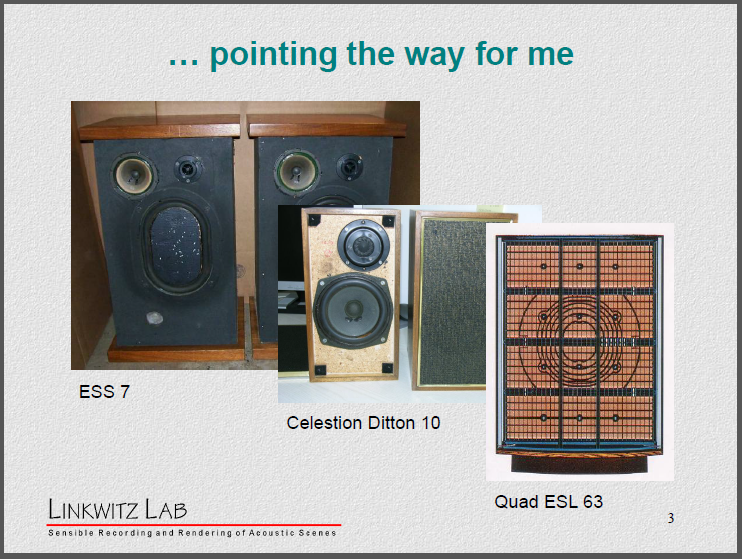
3) … pointing the way for me
Here are 3 loudspeakers that taught me a lot:
The ESS7 sounded good but measured poorly. I
learned about internal stuffing, panel vibrations, transducer placement,
porting, transducer characteristics and crossovers
The Celestion Ditton 10 was a small speaker that could
be equalized with active filters. It also had a small cabinet and thus fewer
secondary radiation issues.
The Quad ESL63 sounded neutral, detailed and open,
but lacked bass output volume. With the large diameter tweeter section it was
also beaming and critical to place optimally in the room.
I thought it should be possible to design a speaker that
has all the good qualities of the Quad and removes its short-comings.
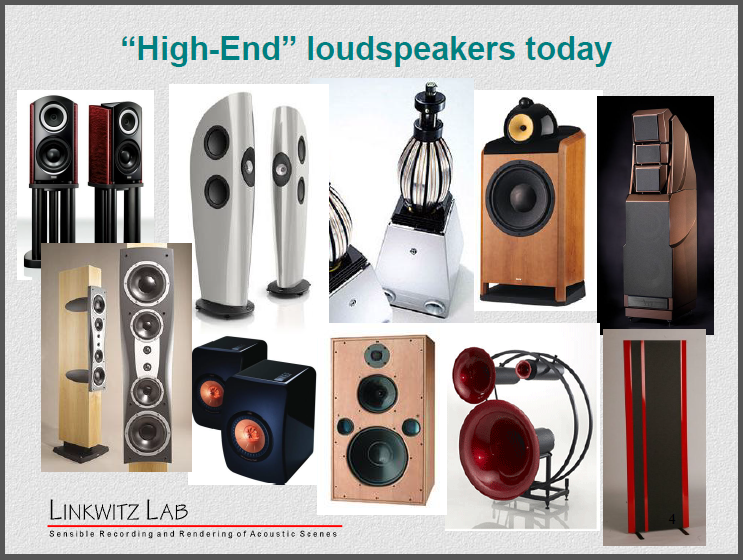
4) "High-End" loudspeakers today
"High-End" loudspeakers today carry a strong
resemblance to the designs from 50 years ago.
But in general the prices have sky-rocketed and cabinet sizes have
increased.
But have these speakers increased the quality of the
illusion or are they merely capable of higher sound levels and lower
non-linear distortion?
Is this much variety of design approaches necessary? What
are the design goals?
>> Before we look at these loudspeakers more closely
we must briefly look at what happened to the quality of the stereo signal due to
process and material changes in the signal path from recording to loudspeaker.
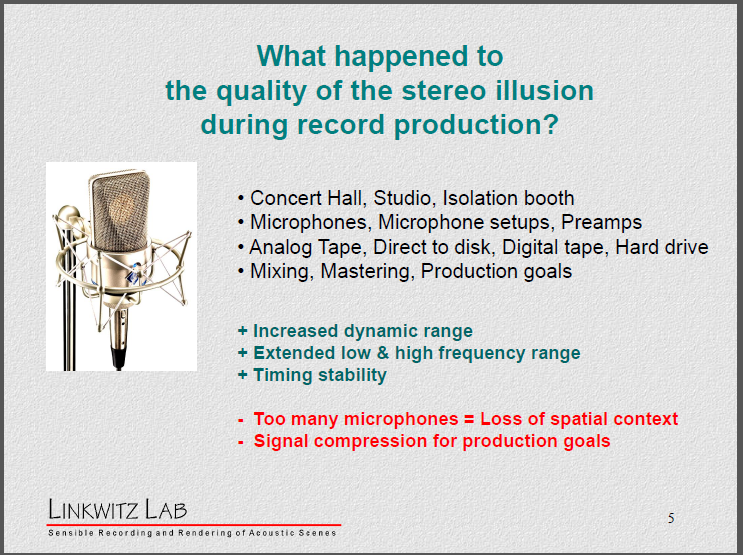
5) What happened to the quality of the stereo illusion
during record production?
During recording and record production we have the
influence of the concert hall, or the recording studio, or the isolation
booth, the microphones and their setup, upon the spatial information
that is being picked up. These acoustics have not changed in the last 50 years..
Analog tape and
direct-to-disk are things of the past and so is digital tape. Today everything
is recorded to hard drive.
And then there are changes in mixing and mastering
practices and in production goals.
On the plus side we have increases in dynamic range,
increases in low and high frequency extension and significantly we have
great improvements in timing stability. No more wow and flutter, but now
some people hear jitter? (= low frequency phase noise sidebands on the digital
clock)
On the negative side, there is the use of too many
microphones and as a result of that a loss of coherent spatial information.
And then there is the heavy use of signal compression to make it sound
loud.
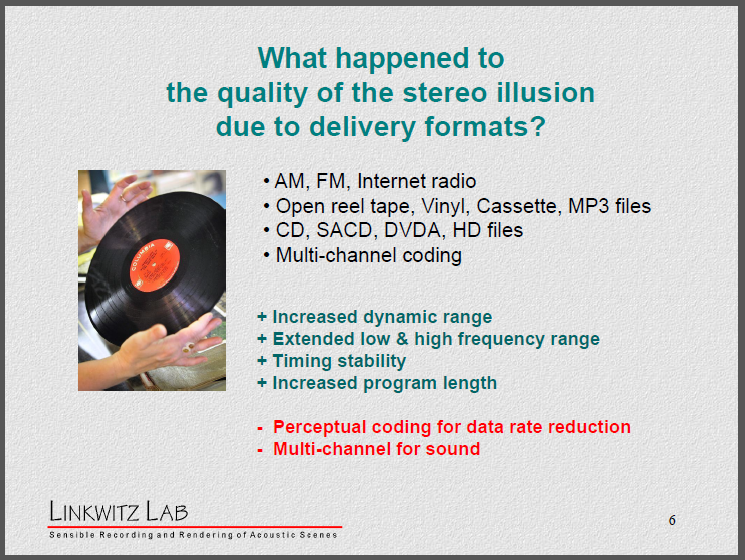
6) What happened to the quality of the stereo illusion due
to delivery formats?
AM and FM radio have been
replaced by internet radio.
Open reel and cassette tape are gone, but vinyl is hanging on though it
is very limiting for producing highest quality playback. Digital disc formats
and digital streaming of high-definition content should by all rights
become quality standards.
But the digital world also has produced lossy coding and the concept of
"good enough"
And then there is multi-channel for sound reproduction, when the
capabilities of stereo have not even been fully understood and exploited.
Multi-channel is fine for theatrical effects but rather crude for music
surround.
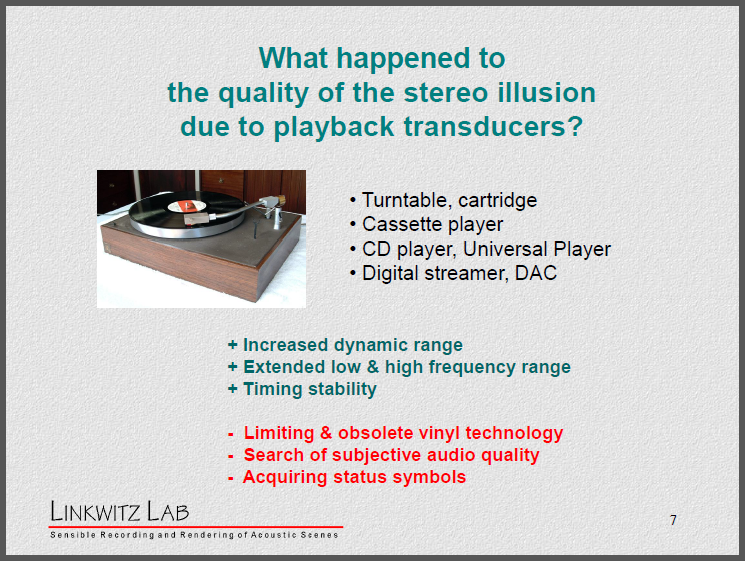
7) What happened to the quality of the stereo illusion due
to playback transducers?
Each delivery format
requires its own transducers to regenerate an electrical signal that can be
amplified and applied to the loudspeaker.
Turntables and cartridges
have reached the pinnacle of their performance, but are ultimately limited in
their capabilities.
Cassette players are obsolete.
Universal players, digital streamers and DACs are the transducers of
choice
With digital transducers we have the potential for
increased dynamic range, like live music, and for its full frequency range,
timing precision and clarity.
With old technologies like vinyl still around we
have a never ending but commercially profitable search for subjective audio
performance.
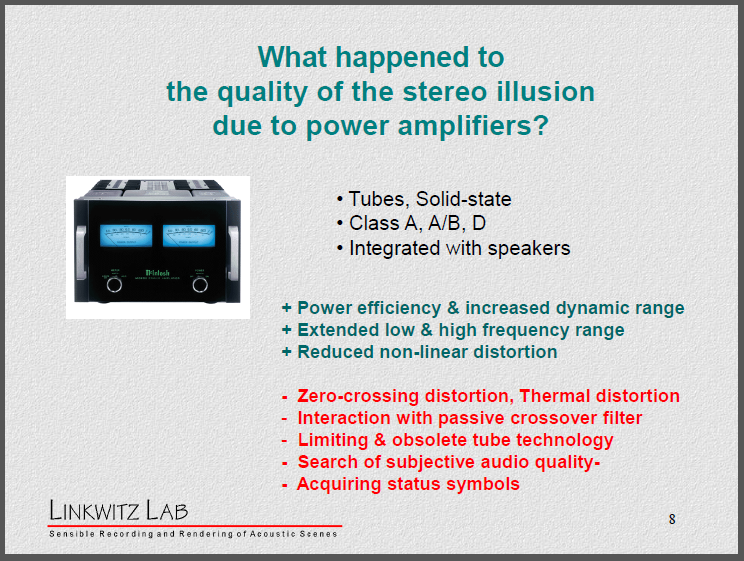
8) What happened to the quality of the stereo illusion due
to power amplifiers?
Here we have seen changes from vacuum tubes to
solid-state devices, to Class A, Class A/B and now Class D pulse modulated
amplifiers.
In professional circles amplifiers are often built into
the loudspeakers.
On the plus side we have increased dynamic range and
power efficiency,
the frequency range is extended because the output transformer has been
eliminated,
and well designed feedback reduces non-linear distortion.
On the minus side we have new forms of distortion from
solid-state devices because they are inherently much faster and wider
bandwidth devices than vacuum tubes. The nastiest distortion can be caused
by the zero-crossings of the output signal when the operating point
shifts dynamically because the thermal feedback loop cannot respond fast
enough.
Also there can be interactions between the amplifier and the passive
crossover in the loudspeaker.
Tube amplifiers are still
popular because their distortions are benign and designing a top notch
solid-state amplifier is a challenging engineering task even today.
All this supports the search for subjective quality and
acquiring status symbols.
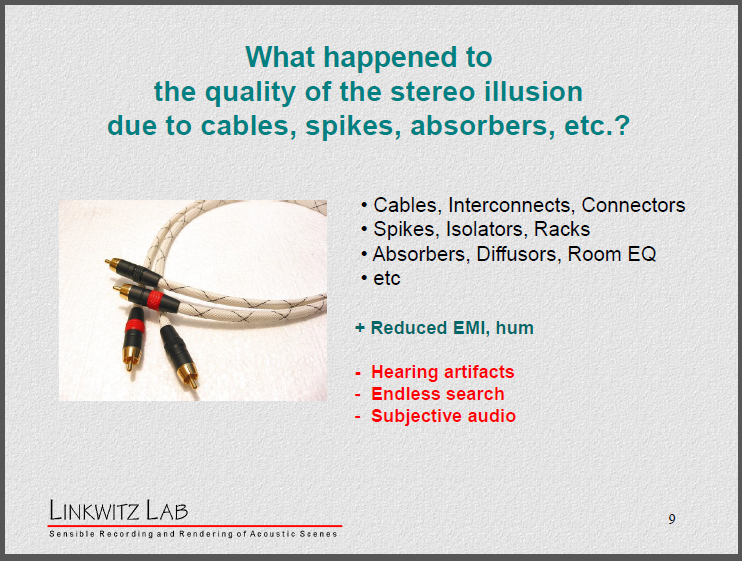
9) What happened to the quality of the stereo illusion due
to cables, spikes, absorbers, etc.?
All of the devices between microphone and loudspeaker have
to be connected with cables that should be shielded against radio
frequency interference pickup and hum. Instead a whole new industry has sprung
up to change the sound - whether real or imaginary - by exploiting
weaknesses in the interface design of audio equipment.
Spikes, isolators and equipment racks may reduce
the transmission of mechanical vibrations and re-radiation by large room
surfaces and can reduce mechanical feedback.
Absorbers, diffusers and electronic room equalization will
change the sound, but these are only remedies to an improperly designed
loudspeaker.
This is a real mixed bag of tricks that has not
helped the reputation of high-end audio
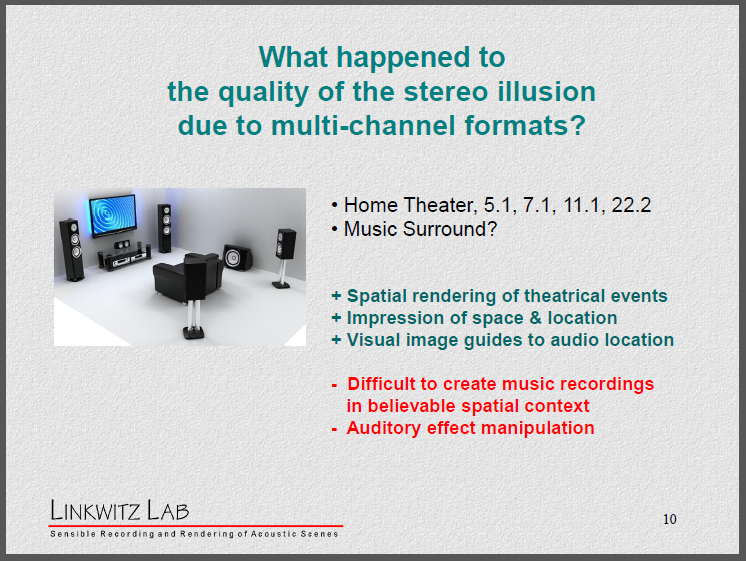
10) What happened to the quality of the stereo illusion
due to multi-channel formats?
Multi-channel sound is driven by the home theater
experience.
If the movie industry and broadcasters have their way then the standard 5.1
setup will go to 7.1 channels, 11.1 and 22.2 channels.
I question the applicability and need of such systems for music
reproduction and only want to point out that it is difficult to create
musical recordings where the many loudspeaker channels create a believable spatial
context. Our brain is very clever in recognizing what is artificial.
So now let’s look the loudspeaker after having mentioned
the improvements and potential problems due to changes in technologies over the
last 50 years:
>> Let’s look at loudspeaker design first
and then at the room where the loudspeaker ends up, and where we judge
the quality of the recording and the whole signal chain.
So what happened to the quality of the stereo illusion due
to loudspeaker design?
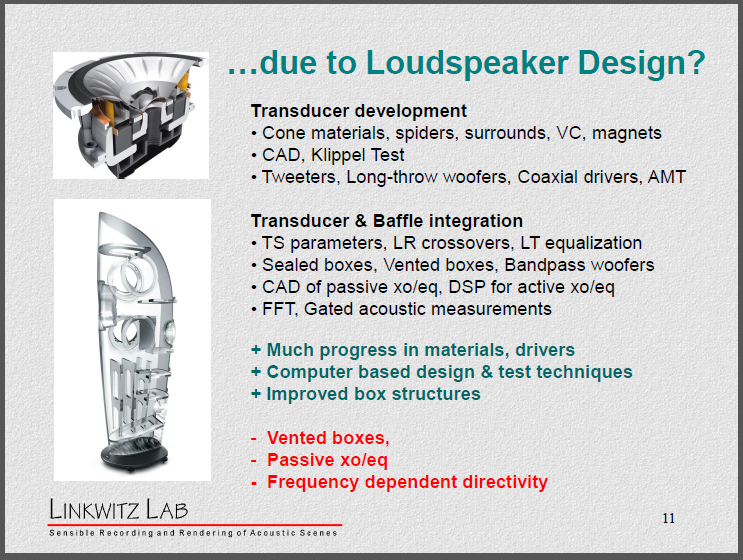
11) … due to Loudspeaker Design
So when looking at loudspeaker design and in particular transducer
development. I do not need to tell you at ALMA that enormous progress
has been made in development and manufacturing of cone materials, spiders,
surrounds, voice coils and magnets.
Computer aided design and test lead to application optimized transducers , such as
super-tweeters, long-throw woofers, coaxial drivers, air-motion transformers,
etc.
Closely related to transducer development is, of course, the
integration of transducer and baffle for control of the acoustical radiation
from
a) the transducer and baffle surfaces and edges and
b) from internal cavities and
c) from vibrations of the baffle surfaces.
Again, at ALMA you are familiar with all the terms
that have come about in the last 50 years:
TS parameters, LR crossovers, LT equalization
Sealed boxes, Vented boxes, Bandpass woofers
CAD of passive xo/eq, DSP for active xo/eq
FFT, Gated acoustic measurements
Much progress has been made in our understanding of
electro-mechanical and acoustic design. Many computer based tools and computer
models are readily available leading to a much higher level of loudspeaker
design than was possible before.
But 3 areas of loudspeaker design remain as hurdles
to obtaining the highest quality in sound reproduction:
1 - Vented boxes. They introduce group delay
distortion and color the bass.
2 – Passive crossover-equalizers. They decouple the power amplifier
from the transducer and give up motion control. They interact with the
transducer.
3 – Frequency dependent directivity. Box loudspeakers radiate
omnidirectional at low frequencies and beam at high frequencies. They feed more
energy at low frequencies into the room’s reverberant field than at high
frequencies.
>>> Why should the off-axis response of
the loudspeaker matter? It determines how the room becomes engaged with
the stereo illusion.
Whatever happened due to loudspeaker and room research?
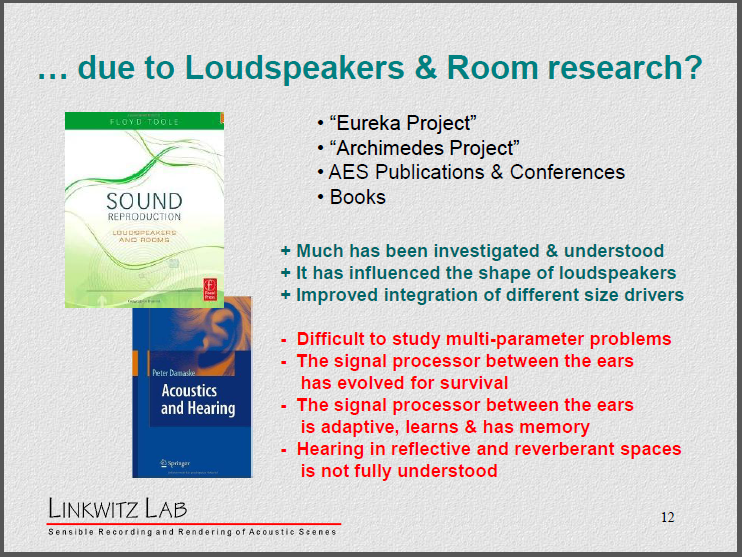
12) … due to Loudspeakers and Room research?
Much research has gone into understanding the effect of room
reflections upon the perceived location of a phantom source and upon
the spatial representation that is generated by a pair of loudspeakers.
The Eureka Project and the Archimedes project were industry and academia
sponsored research projects.
The Audio Engineering Society has published many research papers and
organized Conventions and Conferences to exchange and spread new knowledge.
Books have been published. I mention just two:
Floyd Toole, Sound Reproduction and
Peter Damaske, Acoustics and Hearing
Much has been investigated & understood
It has influenced the shape of loudspeakers
It has improved the integration of different size drivers
Having read much of the published material I come away
with the conclusions
Psycho-acoustics research deals with difficult to study multi-parameter
problems
The signal processor between the ears has evolved for survival and is not
easily fooled
The signal processor between the ears is adaptive, learns & has memory
Hearing in reflective and reverberant spaces is not fully understood
My own investigations of
loudspeakers and how they interact with my listening room have led me from
acoustically small box designs to acoustically small open-baffle designs in an
effort to improve the stereo illusion.
I was fortunate in not
having to design commercial and marketing driven products. I only had to please
myself … and my wife, who has additional criteria for accepting new speakers
into our living room.
>> In the course of my loudspeaker developments I
have raised 3 fundamental questions, for which I have not seen a
scientific answer, but for which I have lots of empirical evidence.
What are these fundamental questions that are so important
to creating a believable stereo illusion?
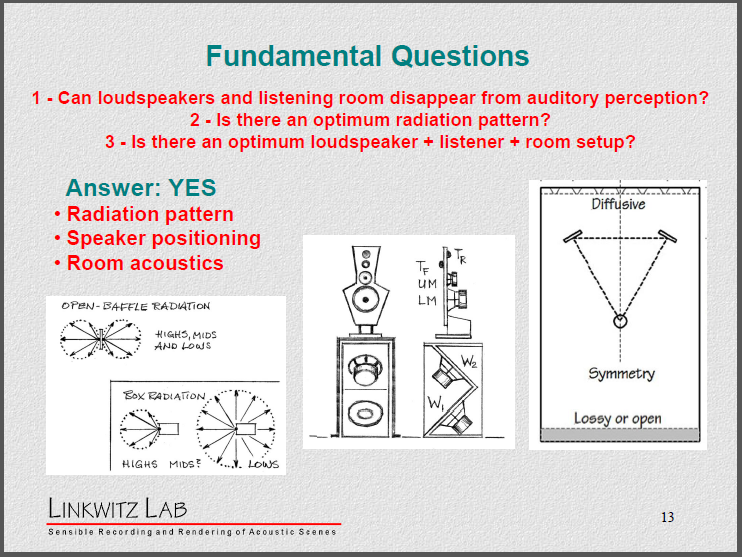
13) Fundamental Questions:
1 - Can loudspeakers and listening room disappear from
auditory perception?
2 - Is there an optimum radiation pattern?
3 - Is there an optimum loudspeaker + listener + room setup?
My answer to all 3 questions is YES!
Provided that we have an appropriate
* Radiation pattern
* Speaker positioning and
* Room acoustics
1) Loudspeaker and room can disappear from perception,
leaving only a phantom auditory scene in front of the listener, provided that
the loudspeakers have essentially frequency independent directivity and provided
that they are set up in the room with some distance from large reflecting
surfaces, That way the reflected and reverberated sounds in the room have the
same tonal character as the direct sound but are delayed such that the brain
focuses on the direct sound and creates the illusion.
2) Here you see the sketch of an optimum directivity
loudspeaker. It is a dipolar radiator from the lowest bass to the top of the
frequency range.
Its radiation pattern is essentially a constant figure-of-eight
at all frequencies. The typical box loudspeaker is omnidirectional at low
frequencies and becomes more and more directional at high frequencies.
The optimum setup is symmetrical with respect to
reflecting surfaces with the loudspeakers at some distance from them. The
sweet spot is at the apex of the equilateral triangle, So nothing is new here,
except that the sweet spot becomes very wide. The sound does not change
when listening at greater distance or off-axis. Only the precision of imaging
changes.
The listening room itself is optimized by being diffusive
behind the loudspeakers and absorbing the sound behind the listener. Rather
than a closed box the room should be thought of as a waveguide. The sound
from the loudspeaker end of the room travels towards and past the listener and
disappears without reflection. While this ideal may not always be achievable it
can serve as a guide of where to provide diffusive and absorptive room
surfaces.
With this type of room, this type of loudspeaker and
listening room setup it is left up to the recorded material to establish
the quality of the illusion.
>> So let me look at some of today’s recording
monitors to see if they are up to the task
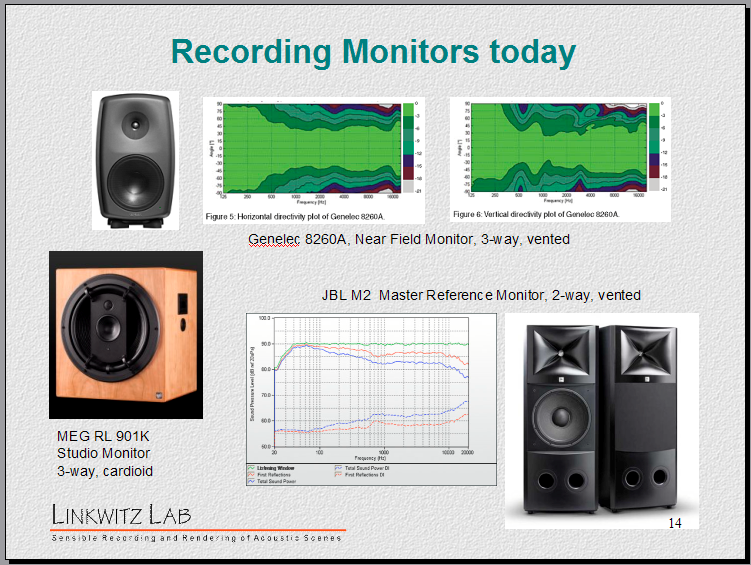 . .
14) Recording monitors today
Here are 3 examples.
First we have a near-field monitor like the Genelec
3-way. It has smoothly controlled and relatively wide horizontal dispersion. The
recording engineer sits very close to the speakers so that the ratio of
direct to reverberant sound is very high, almost like with headphones,
but without the in-head localization and spatial distortion of headphones. Since
these are relatively small speakers it can be difficult to judge the proper bass balance
of a recording.
The speakers have built-in power amplifiers and active equalization and
crossover.
The MEG studio monitor is a 3-way. It is a cardioid
up to about 200 Hz from where the forward directivity of the large woofer driver
takes over. Thus the speaker’s directivity increases less between low and high
frequencies. In an acoustically dead mixing room with RT60 of 250 ms they are
effective tools for music production and popular with Tonmeisters in Germany.
The JBL M2 exemplifies the work of Floyd Toole
about loudspeakers and rooms. It has wide and controlled dispersion, low
non-linear distortion and high dynamics. But it is also ported like the
Genelec.
These monitors are designed for work in rooms with dead
acoustics, not what we typically have in the home. These monitors are
analytical tools for making recording decisions and not used for music
enjoyment at home with its wide range of room acoustics.
It is certainly possible for experienced recording
engineers to make excellent recordings using these types of monitors.
>> How such recordings are rendered in the home
depends upon the loudspeaker and the listening room, which is typically not
especially designed for audio reproduction.
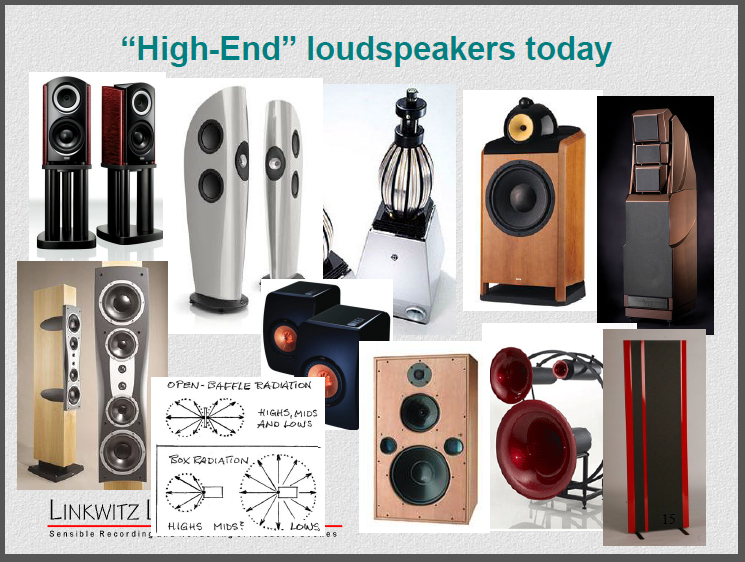
15) "High-End" loudspeakers today
Here are 10 examples of highly rated loudspeakers, which
are representative of the "high-end" today. All are very pricey
except for the small KEF LS50 two-way speaker in the center.
There are some real engineering marvels amongst
these speakers, like the MBL Radial Strahler. It is the only speaker amongst
these that has constant directivity at all frequencies. Horizontally it is
omni-directional – as in this graph - and thus would meet my criteria for a
high sound quality speaker, but unfortunately it has vented ports for unnatural
bass enhancement. Besides, some directionality, like in a dipole or
cardioid, is advantageous because it increases the direct to reverberant
ratio at the listening position.
With the exception of the horn speakers and the
Magneplanar open-baffle radiator, all speakers here have ports. Also
all use passive crossovers and external power amplifiers.
The Magneplanar uses large radiating panels and a
long high frequency ribbon is not an acoustically small radiator and therefore
has radiation lobes. It makes its interaction with the room difficult to
predict. It also suffers in bass volume capability. Never-the-less it
comes close to my ideal loudspeaker concept.
The horn loudspeakers next
to it are highly directional, but their directionality varies considerably with
frequency of radiation. They are multi-beamers. Thus the reverberant field in
the room is relatively weak for most frequencies. To me they sound like big
headphones at a distance, creating a phantom scene that is uncomfortably
close and colored.
The TAD 3-way and KEF Blade use a coaxial design of
midrange and tweeter, which gives a smooth transition in the polar pattern
between the two transducers and a smooth roll-off in the off-axis response as
the speaker becomes increasingly forward directional with higher
frequency. Again, they are omnis at low frequencies.
Both speakers and most others hereuse strategically placed
internal bracing to minimize spurious radiation from the enclosure
surfaces. All the box speakers here must deal with the acoustic cavity behind
the cone and how to dissipate the airborne energy that should not be re-radiated
into the room.
The B&W 801 speaker goes for wide horizontal
and vertical dispersion and low diffraction with its spherical midrange and
tweeter baffles. But it does not go far enough to produce a neutral sounding
reverberant field in the room.
The Dynaudio loudspeaker with its symmetrical vertical
driver arrangement achieves a narrow vertical radiation pattern, but
possibly with lobing.
The Spendor box speaker continues in the BBC tradition of
monitor design and has in my opinion a host of cabinet and diffraction issues.
Again it really exemplifies what is wrong with the box loudspeaker paradigm and its
generic loudspeaker sound.
The best recognized of this type of box speakers is
probably the Wilson line of speakers, to the point of having become status
symbols.
>> So, whatever happened to the quality of
reproduced sound in the home?
By quality I mean: How close have we come to creating the illusion of a live
acoustic event in the home?
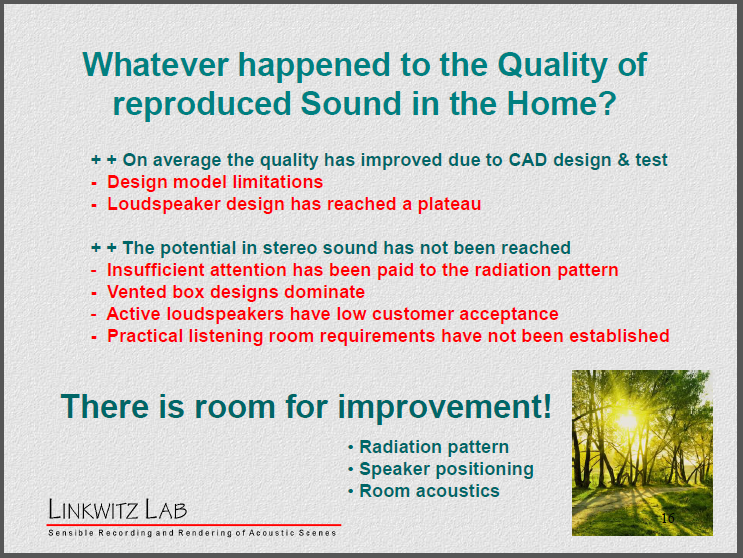
16) Whatever happened to the quality of reproduced sound
in the home?
+ On the plus side and on average
the quality has improved due to CAD design & test .
- But computer design models have limitations in
how accurately they represent reality and in what they leave out.
- As a result loudspeaker design has reached a plateau
and is stuck in the box speaker paradigm
+ The potential in stereo sound has not been reached
- Insufficient attention has been paid to the radiation
pattern
- Vented box designs dominate. They produce a generic
loudspeaker bass character.
- Active loudspeakers have low customer acceptance
though they give greater design freedom than passive crossover/equalizers
and could improve the quality of speakers.
- Practical listening room requirements have not
been established. The audio industry has provided little guidance to the
consumer on room acoustics and speaker placement.
+++ There is room for improvement!
+ The potential in the realism of stereo sound has not
been reached
We have seen great technical advances in the last
50 years that have changed what is possible in audio recording and rendering.
Loudspeakers are an old and almost mature technology. Loudspeakers have followed
the call of marketing in selling subjective sound rather than following
technology in improving the realism of the sound experience.
I was just fortunate that I could built for myself, what
pleased me and without obligation to someone else. But what I have talked about
here, what more could be done with loudspeakers and rooms, is disruptive to
long established procedures and beliefs. It may never become a commercial
success.
But one can hope that the full potential in stereo will
become recognized. Think about it, two information streams are all that the ear
and brain need for orientation in auditory space, provided that the ear signals
change properly with head movement. That is what two loudspeakers will do for
you.
Thank you for giving me this opportunity to talk to you.
You are the ones who can make higher quality audio a reality!
==============================================================
Summary from ALMAgrams newsletter, Volume
54, No.1:
"Day one ended with ALMA's festive
Driver Award Banquet. Siegfried Linkwitz delivered an exceptional keynote
address and thought provoking challenge to the industry leaders, CEO's, and
design engineers (as well as those who missed out on this opportunity):
loudspeaker development has reached a plateau and needs to return to the goal of
attaining realism. The challenge was found to be inspiring and met with renewed
enthusiasm and much discussion during the ensuing cocktail hour."
Top of page
|